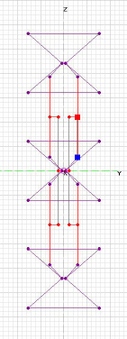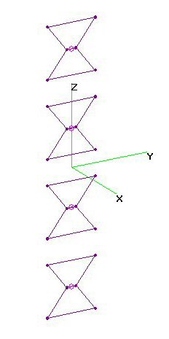 | 1.
UHF 2-Bay Hourglass-Loops - NO Refl (19 Nov 2014)UHF 2-Bay Hourglass-Loops analyzed using 4nec2.
All dimensions were determined using nikiml's Python Optimization Scripts.
SAME as analysis for Vertical Stacked Hourglass-Loops found here:
http://imageevent.com/holl_ands/stacked/verticallystackeduhf/vertstackuhfhourglassloopnorefl
UHF Hourglass-Loop has a VERY WIDE Beamwidth of 80-deg at 470 MHz, decreasing to 70-deg at 698 MHz.
Vertically Stacked, remains 80-deg at 470 MHz, decreasing to 60-deg at 698 MHz (to within 10-deg resolution).
Two versions are presented here, the first presumes the use of an RF Combiner attached
to Antenna Feedpoints using Baluns & Equal Length Cables. The second avoids 0.5-1.5+ dB Loss
in RF Combiner by using an Optimized Vertical Interconnection Harness.
a) RF Combiner: Vertical Stacking (Center-Center), VD = 18-in provides Max Raw Gain per Optimizer.
UHF Raw Gain = 7.6 to 9.6 dBi and SWR (300-ohms) under 1.9.
Hi-VHF Raw Gain = 4.4 to 4.9 dBi and SWR (300-ohms) = 103 to 33 is Excessive.
=====================================
b) Holl_ands Vertical Harness: Vertical Stacking (Center-Center), VD = 24.75-in provides Max Raw Gain
per Optimizer. See 4nec2 File for all Dimensions, including Re-Optimized Hourglass-Loop sizes.
UHF Raw Gain FORWARD = 7.8 to 9.7 dBi, F/B & F/R Ratio has small (1.3 dB) increase at
high frequencies (just -0.1 dB at low frequencies), and SWR (300-ohms) under 2.1.
Hi-VHF Raw Gain = 4.6 to 5.6 dBi and SWR (300-ohms) = 67 to 33 is Excessive.
Dimensions of HVH wires were determined using nikiml's Python Optimization Scripts:
VS = 12.25-in = Vertical Stacking Distance (Center-To-Center).
VS/2 = 6.125-in, Length of Harness wires from Feedpoint to Center of each Hourglass-Loop.
Diagonal = 3.25-in, Length from Harness Wires to each Hourglass-Loop Feedpoint.
Hw = 0.80-in (may round to 0.75-in),
Xh = -3.25-in = Harness X-Axis Separation from Hourglass-Loops.
TOTAL HARNESS WIRE LENGTH (2 required) = 19.75-in = 2x6.125+2x3.25+2x0.5 (for eyelets) |
| 6026 Visits
42 Images
Gallery Album | |
|
 | 2.
UHF 3-Bay Hourglass-Loops - NO Refl (19 Nov 2014)UHF 3-Bay Hourglass-Loops (NO Reflector) analyzed using 4nec2 after determining best
dimensions using nikiml's Python Optimization Scripts.
Compare to performance of 2-Bay Hourglass-Loop with HVH:
UHF Raw Gain FORWARD = 7.8 to 9.7 dBi, F/B & F/R Ratio has small (1.3 dB) increase at
high frequencies (just -0.1 dB at low frequencies), and SWR (300-ohms) under 2.1.
Hi-VHF Raw Gain = 4.6 to 5.6 dBi and SWR (300-ohms) = 67 to 33 is Excessive.
=====================================
Multiple versions were analyzed with different methods for Combining Antennas:
a) Three EX Statements, emulating a PERFECT 3-Way Combiner.
UHF Raw Gain = 9.6 to 11.6 dBi and SWR (300-ohms) Under 1.9.
Hi-VHF Raw Gain = 5.7 to 6.6 dBi and SWR (300-ohms) = 69 to 23 is Excessive.
Roughly 2 dB higher UHF Raw Gain than 2-Bay....most would be lost in a REAL 3-Way RF Combiner.
=====================================
b) Two "Shortest Path" Feedlines From Center, SAME Width as Hourglass Center Wire.
Disappointing...NO Gain improvement versus 2-Bay on low freqs and only 0.4 dB more on high freqs.
UHF Raw Gain = 7.8 to 10.1 to 9.6 dBi
Up to 0.2 dB MORE Forward on Lower Channels and SWR (300-ohms) Under 3.7.
Hi-VHF Raw Gain = 5.1 to 6.5 dBi and SWR (300-ohms) = 30 to 55 is Excessive.
Max UHF Gain is only 0.3 dB higher than 2-Bay with higher SWR, so ANOTHER approach is needed.
=====================================
c) Two "Shortest Path" Feedlines End-Fed from Bottom, SAME Width as Hourglass Center Wire.
Very Poor UHF Performance.
=====================================
d) Two HVH (Holl_ands Vertical Harness) Feedlines From Center.
Disappointing...NO Gain improvement versus 2-Bay on low freqs and only 1 dB more on high freqs,
although Hi-VHF SWR improved some, but was still Excessive.
UHF Raw Gain = 7.8 to 10.6 dBi and SWR (300-ohms) Under 1.8.
Hi-VHF Raw Gain = 3.9 to 4.5 dBi and SWR (300-ohms = 17 to 4.2 is Excessive.
=====================================
e) Double Tier HVH: Two HVH (Holl_ands Vertical Harness) Feedlines From Center, with their mid-points
fed from a Common SOURCE via another pair of Feedlines.
BEST Feedline arrangement, provides about 3 dB more UHF Raw Gain that 2-Bay Hourglass-Loop.
Hi-VHF Raw Gain is significant, directed forward but with Excessive SWR.
UHF Raw Gain = 10.6 to 12.5 to 12.4 dBi, F/B & F/R Ratio = 1.2 to 2.8 dB
and SWR (300-ohms) under 2.3. REVERSE UHF Raw Gain = 9.4 to 9.2 to 9.7 to 9.6 dBi.
Hi-VHF Raw Gain = 5.3 to 6.8 dBi with slightly (0.1 to 0.2 dB) more Gain to REAR
and SWR (300-ohms) = 11.4 to 8.1 is Excessive. |
| 4884 Visits
93 Images
Gallery Album | |
|
 | 3.
UHF 4-Bay Hourglass-Loops - NO Refl (28 Nov 2014)UHF 4-Bay Hourglass-Loop (NO Reflector) analyzed using 4nec2 after determining best Dimensions
using nikiml's Python Optimization Scripts.
Five alternative versions were analyzed to find the "Best" (version b):
=====================================
a) 4 EX Statement Emulate a ZERO LOSS 4-Way Combiner, which would have 1-4+ dB Loss
that is NOT shown in these Results:
UHF Raw Gain = 11.0 to 13.0 dBi and SWR (300-ohms) is under 2.0.
Hi-VHF Raw Gain = 7.0 to 7.8 dBi and SWR (300-ohms) = 72 to 27 is Very Excessive.
=====================================
b) Double Tier HVH: Two HVH (Holl_ands Vertical Harness) Feedlines Interconnect Outer Pairs
of Hourglass-Loops, with the HVH mid-points fed from a Common SOURCE via a THIRD HVH.
BEST Feedline arrangement, provides about x dB more UHF Raw Gain that 2-Bay Hourglass-Loop.
Hi-VHF Raw Gain is significant, mostly Bi-Directional but with Excessive SWR on lower Channels.
UHF Raw Gain = 11.1 to 12.6 dBi, F/B & F/R Ratios = 0.8 to 4.2 dB and SWR (300-ohms) is under 1.8.
Hi-VHF Raw Gain = 4.8 to 6.1 dBi is 0.1 to 0.25 dB HIGHER to REAR and SWR = 11.9 to 2.6 is
Excessive on Lower Channels.
=====================================
c) HVH Feedlines interconnect all adjacent pairs of Hourglass-Loops, fed from Center of the Antenna.
For consistency with next two alternatives, Tops and Bottoms of Hourglass-Loops are swept back 0.5-in
to prevent hitting Feedlines. Raw Gain was significantly less than either of above, so is not recommended.
Hence only a few performance Charts are provided here:
UHF Raw Gain = 9.2 to 12.3 to 12.0 dBi and SWR (300-ohms) is Under 2.9.
=====================================
d) "Shortest Path" Feedlines WITHOUT CROSSOVERS interconnect all adjacent Hourglass-Loops,
where Feedline Width is SAME as Center Gap in each Hourglass.
Raw Gain was significantly less than above with High SWR, so is not recommended:
UHF Raw Gain = 9.2 to 12.0 to 11.6 dBi and SWR (300-ohms) Under 4.2 is HIGH.
=====================================
e) "Shortest Path" Feedlines WITH CROSSOVERS interconnect all adjacent Hourglass-Loops,
where Feedline Width is SAME as Center Gap in each Hourglass.
Unexpectedly, Raw Gain was significantly LESS than above, so is not recommended:
UHF Raw Gain = 8.7 to 10.4 and SWR (300-ohms) is Under 1.5. |
| 2958 Visits
60 Images
Gallery Album | |
| |